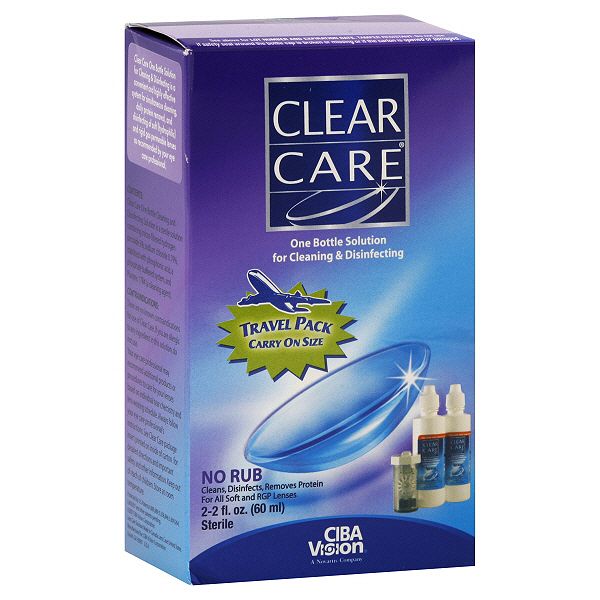Note: By using the information presented in this blog, you agree to the terms described in the post entitled "Mission Statement and Disclaimer." Basically, you can't sue.
Clear Care
Overview: Clear Care, by CIBA Vision, is a new lens cleaner solution. However, unlike most lens cleaner solutions, this uses hydrogen peroxide. The hydrogen peroxide presumably disinfects and removes protein from the lenses better than an enzymatic cleaner. Plus, the bubbling is really cool to watch.
Mechanics: There are really two main things that a lens cleaner does. First: disinfect it. Second: remove proteins.
Disinfecting the lens basically keeps your eye from becoming infected by bacteria or fungus. This is pretty important, and not always guaranteed, considering that Bausch & Lomb’s ReNu with MoistureLoc actually caused fungal infections, leading to a lawsuit from some 600 users.
Removing proteins from the lenses will keep your lenses “fresher” longer. These proteins naturally come from your eyes, and when they build up on your
lenses, will make them feel “thicker,” less flexible, dryer, and can even prevent oxygen from reaching your eye. Protein buildup on a lens is like caking your skin with mud. Your skin will be thicker, less flexible, dryer (because the mud will absorb any natural moisture from your skin), and your skin can’t breathe because its pores are being blocked up.
lenses, will make them feel “thicker,” less flexible, dryer, and can even prevent oxygen from reaching your eye. Protein buildup on a lens is like caking your skin with mud. Your skin will be thicker, less flexible, dryer (because the mud will absorb any natural moisture from your skin), and your skin can’t breathe because its pores are being blocked up.
The way that Clear Care both disinfects and removes proteins is by using hydrogen peroxide. Hydrogen peroxide naturally breaks down into H2O and a single oxygen atom, called a free radical. Free radicals are really reactive, reacting with whatever organic molecule that’s nearby. Of course, by reacting, we mean that it destroys it. Think of a free radical as a spark that can light anything on fire.
This means that the hydrogen peroxide can destroy most, if not all, germs and bacteria and fungi that surround the lenses. Basically, a bacteria or fungus cell has a skin. And like us, if you destroy that skin, you destroy the life of that germ. Its contents spill out, and the insides get destroyed. The only way a germ can cause trouble is by reproducing, because when it makes more of itself, there are more germs, which can release even more waste (just like us, any living organisms “poops”). But when we destroy the skin of a germ, the insides spill out and can’t work together, kind of like if you dismantle the pieces of your computer it’ll stop working.
I wish I could claim that I had my little four year old draw this, but alas, it is indeed my crappy little drawing.
So the hydrogen peroxide does a great job in disinfecting, but what about removing proteins? Well, it’s not as great as disinfecting. It turns out that punching holes in the skin of a huge bacteria cell is a lot easier than destroying a much smaller protein molecule. It’s as if you have a bag of popcorn (the cell), compared to a single popcorn (the proteins). Sure, it’s easy to rip a hole somewhere in the bag, but it’s harder to rip apart every single popcorn piece. Especially when those popcorn pieces are stuck into your carpet (the surface of the lens).
Still, the company claims that the “bubbling action removes protein, dirt and build-up.” So basically, as the little bubbles float up, they’ll kind of rub against the surface of the lens, pushing away the proteins.
The metal catalyst just makes the reaction go fast enough. Normally, if you just put your lens in a bottle of hydrogen peroxide solution, there won’t be much bubbling. If you watch the lens case closely, most of the bubbles being produced are from the metal catalyst. The metal catalyst doesn’t cause the hydrogen peroxide to break down into water and oxygen, but it does make it go much faster. A process that could take days or even weeks to finish is done in less than six hours, keeping the cleaning process merely overnight.
Most Clear Care packages contain two bottles of solution. I'd buy this over the single one simply to save money, and save the environment extra lens cases. Click on the picture to purchase online.
Click on the picture above to purchase directly at K-mart. Alternatively, you might be able to find this product here, unlike the local CVS and other chain drug stores. These vendors give pretty huge discounts, and often (but not always) free shipping.
Soap.com
Be sure to check out Part II of this topic




Awesome write up!
ReplyDeleteHydrogen peroxide solutions are the only way to kill Acanthamoeba, which led to the recall of Complete contact lens solution back in 2007.
ReplyDeleteMultipurpose solutions simply do not work against Acanthamoeba, probably because the cyst form renders it resistant to many chemicals. Because peroxide solutions work by oxidation, though, it can break down the cysts.
Cleaning Summerstown Once you’ve selected the company of your desire, call their office, or make contact online. The better part of cleaning companies, have really good websites, with 24 hour surveillance and customer support. End of lease cleaning Melbourne is one of many companies, which offer their services in a very wide service area. But it is up to you to decide. Maybe there is another company, which will charge you less.
ReplyDelete